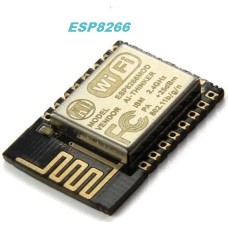This is the ESP-12 with SPI and extra GPIO pins along the bottom of the PCB (which explains the model number ESP12E). Note that the pinout labels on the PCB may be incorrect, please see the diagram in the images above - and although labelled as such you cannot use GPIO9 and 10 on this board.
Please note that there is no "formal" structure for ESP8266-based software environments, and everything provided is by the community of users and not the creator or suppliers of ESP8266-based hardware. Due to this we do not offer detailed support for coding and only offer a hardware warranty.
This one is all mounted on a tiny board along with a PCB antenna. All the I/O pins are broken out and you can design your PCB around this, or simply nudge some inline connectors to the PCB for a quick solder job, or solder some tiny tiny wires into the holes. Furthermore this ESP-12E variant has the "metal can" for extra shielding.
Note - this is a 3.3V part. 5V will kill it. So don't directly connect it to your Ardiuno Uno or similar board! Get yourself a level converter instead.
Furthermore, this ESP12-E has extra I/O and SPI pin interfaces - MTDO, MTDI, SD_3, MTMS, MTCK, SD_2.
This is a WiFi serial transceiver module, based on ESP8266 SoC. The SOC has Integrated TCP/IP protocol stack. To get started and for a couple of tutorials, see the "Resources" links below. ESP8266 is a highly integrated chip designed for the needs of a new connected world. It offers a complete and self-contained Wi-Fi networking solution, allowing it to either host the application or to offload all Wi-Fi networking functions from another application processor.
ESP8266 has powerful on-board processing and storage capabilities that allow it to be integrated with the sensors and other application specific devices through its GPIOs with minimal development up-front and minimal loading during runtime. Its high degree of on-chip integration allows for minimal external circuitry, and the entire solution, including front-end module, is designed to occupy minimal PCB area.
More information:
- SDIO 2.0, SPI, UART
- 32-pin QFN package
- Integrated RF switch, balun, 24dBm PA, DCXO, and PMU
- Integrated RISC processor, on-chip memory and external memory interfaces
- Integrated MAC/baseband processors
- Quality of Service management
- I2S interface for high fidelity audio applications
- On-chip low-dropout linear regulators for all internal supplies
- Proprietary spurious-free clock generation architecture
- Integrated WEP, TKIP, AES, and WAPI engines
Specification:
- 802.11 b/g/n
- Wi-Fi Direct (P2P), soft-AP
- Integrated TCP/IP protocol stack
- Integrated TR switch, balun, LNA, power amplifier and matching network
- Integrated PLLs, regulators, DCXO and power management units
- +19.5dBm output power in 802.11b mode
- Power down leakage current of <10uA
- Integrated low power 32-bit CPU could be used as application processor
- SDIO 1.1/2.0, SPI, UART
- STBC, 1×1 MIMO, 2×1 MIMO
- A-MPDU & A-MSDU aggregation & 0.4ms guard interval
- Wake up and transmit packets in < 2ms
- Standby power consumption of < 1.0mW (DTIM3)
This is a WiFi serial transceiver module, based on ESP8266 SoC. The SOC has Integrated TCP/IP protocol stack. To get started and for a couple of tutorials, see the "Resources" links below.
Resources
- SDK from Expressif
- Espressif AT Instruction Set(Chinese)
- ESP8266 Specifications(Chinese)
- Quick Arduino tutorial from Seeed
- Another tutorial including AT commands
- ESP8266 Forum
- Example Arduino/Android application
- Excellent example Arduino project
- Browser-based LED colour chooser with NeoPixels
- Using ESP8266 and Arduino Mega ... as a web-browser
Package Includes:
- ESP8266 Development Board
ESP8266 ESP-12E WiFi board with full I/O external SPI and PCB antenna
- Product Code: WiFi-02
- Availability: 5
-
Rs. 299.00
- Ex Tax: Rs. 299.00
Tags: ESP8266 ESP-12E WiFi board with full I/O external SPI and PCB antenna, WiFI, ESP8266


